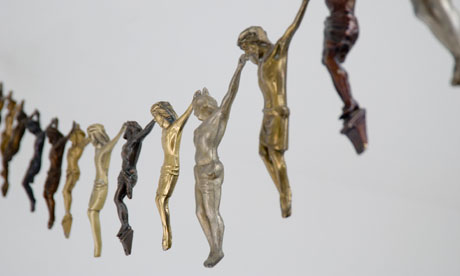Artist of the week 105: Kris Martin

Kris Martin's Festum, OVER 200 found Christ figurines in a 'paper-chain' formation. Photograph: Courtesy White Cube
In 2007, the young Belgian conceptualist Kris Martin achieved what most artists only dream of and brought Frieze, London’s major art fair, to a standstill. The cacophony of dealers and well-heeled collectors fell to a complete hush, when a voice announced over the microphone that there would be a minute’s silence. Whatever else people thought of in that brief interim, with a simple instruction he had suddenly drawn the entire crowd’s attention to the present moment.
This dazzlingly simple method for getting people to consider time is typical for Martin, whose work is full of endings and beginnings. One of his best-known pieces, Vase from 2005, involves smashing a replica Ming vase and then glueing the whole thing back together each time it’s exhibited in an ongoing act of quick destruction and painstaking resurrection. New ideas similarly rise from the ashes in a series of works on paper that feature the closing fullstops from his favourite books, from The Brothers Karamazov to Teddy Bear on Holiday. Is that final black dot the end of the tale, or the moment the book’s significance starts to take hold? More bleakly, in Mandi III from 2003, a train station clock with its numbers removed clicks around in an endless void where there are no longer any arrivals and departures.
Though his works are now sold by one of London’s major commercial galleries, White Cube, Martin’s path into the art world was far from conventional. After studying architecture, he began making projects for his own amusement. His first big break was when the esteemed Belgian-born curator Jan Hoet invited Martin to participate in the septennial Dutch exhibition Sonsbeek, alongside the likes of rising art stars Gelitin and Cai Guo-Qiang in 2001, following a studio visit.
Martin often spikes his work with an impish, self-deprecating humour, revealing the absurdity of our aspirations to longevity, even as he falls foul of those vanities himself. But if it’s history that ultimately decides who today’s great artists will be, he’s left future generations something that will guarantee somebody somewhere remembers him. His bronze sculpture, 100 Years, doubles as a bomb set to detonate in a century, as an engraving on its underside informs us. As in life, the tick-tock of mortality is a constant in Martin’s work, making us think about what comes next with something as ingeniously succinct as an explosion or a full stop.
Why we like him: In a chilling act of excision, Mandi IV from 2007 reconfigures one of antiquity’s most famous works, Laocoön and His Sons. Martin’s replica has lost the snakes the brawny trio wrestle with, so that their agonised faces and grasping empty arms suggest both pointless struggle and how the march of time erases meaning.
Fool’s gold: Dostoevsky’s The Idiot is Martin’s hero. When he had his own coin made by Milanese goldsmiths in 2005, one side depicted the artist’s head, the other his currency: 1 idiot.
Where can I see him? White Cube Hoxton Square, London, until 9 October.
• This article was amended on 13 January 2011. The original referred to Jan Hoet as the esteemed German curator. This has been corrected.
guardian.co.uk © Guardian News & Media Limited 2010
Published via the Guardian News Feed plugin for WordPress.
